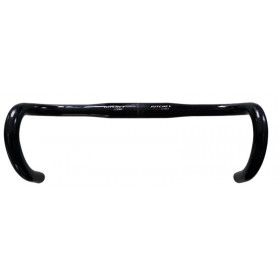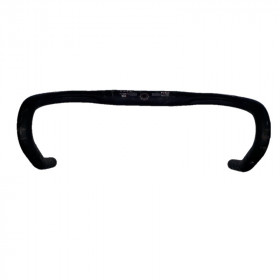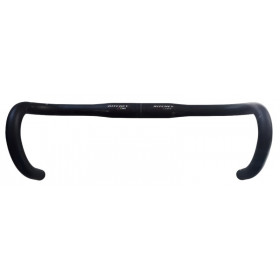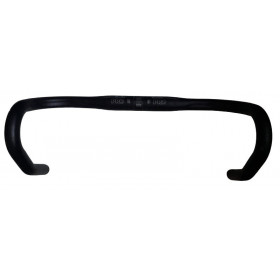-
 New productCarbon road Ritchey WCS logic curve handlebar 45 cms
New productCarbon road Ritchey WCS logic curve handlebar 45 cms- €149.99
-
 UsedRoad handlebar Pike GAAS 44 cms OS
UsedRoad handlebar Pike GAAS 44 cms OS- €8.99
-
 UsedBontrager VR-S OS compact handlebar
UsedBontrager VR-S OS compact handlebar- €19.99
-
 UsedAluminium Ritchey WCS logic curve handlebar 46 cms
UsedAluminium Ritchey WCS logic curve handlebar 46 cms- €9.99
-
 UsedErgonomic road handlebar PRO LT 44 cms OS
UsedErgonomic road handlebar PRO LT 44 cms OS- €10.99
Showing 1-5 of 5 item(s)
Road bike handlebars: everything you need to know to choose the right one
Road bike handlebars are much more than just a steering component. They play a key role in the cyclist's performance, comfort, and posture. Whether aluminum or carbon, flat or compact, each road bike handlebar has specific characteristics that influence your riding style, whether you enjoy long rides or are a competitive rider.
In this article, we review the different road bike components that make up the front of the cockpit: road bike handlebars, road bike stem, and shifters, not to mention the criteria to consider when making the right choice.
1. The different types of road bike handlebars
Traditional handlebars
The classic road bike handlebar, shaped like a drop bar, is recognizable by its downward curvature. It allows for a variety of hand positions, ideal for alternating between aerodynamics, power, and comfort.
Flat road bike handlebars
Less common on road bikes, flat road bike handlebars are similar to those found on mountain bikes. They offer a more upright position and better control, especially for beginners or urban commuters. This type of handlebar is also popular with some cyclists on gravel bikes or hybrid bikes.
2. Materials: aluminum or carbon?
Aluminum handlebars
Strong and affordable, aluminum handlebars remain a benchmark for cyclists looking for good value for money. They offer good stiffness but remain slightly heavier than their carbon equivalents.
Carbon road bike handlebars
Carbon road bike handlebars are prized for their lightness, optimal stiffness, and ability to filter road vibrations. Ideal for cyclists seeking performance and comfort over long distances, they are available in compact, ergonomic, or aerodynamic versions. Carbon road bike handlebars are often used in competitions or on high-end bikes.
3. Choose the right width and shape
The width of road bike handlebars should ideally match the rider's shoulder width. This harmony promotes a natural posture, better control, and fluid breathing. Handlebars that are too narrow can compromise stability, especially when descending or cornering, while ones that are too wide increase wind resistance and can tire the shoulders over long distances.
But beyond width, handlebar shape plays an essential role in comfort, aerodynamics, and load distribution. Here are the main shapes available:
Compact
Compact handlebars are one of the most common on modern road bikes. They are characterized by a reduced drop and reach, facilitating access to the hoods and handlebar grips at the bottom of the handlebar. This shape allows for quick and easy position changes while maintaining a relatively upright posture. Perfect for long distances, touring, and cyclists seeking comfort.
Anatomical
This type of handlebar features a more angular and pronounced shape in the lower section, with ergonomic support for the hands. The goal is to provide a natural and stable grip in the hollow of the handlebar, ideal for long, rolling sections. It is well suited to cyclists who spend a lot of time with their hands down, particularly in competitions or intense training.
Aerodynamics
Aerodynamic handlebars feature a streamlined shape to reduce drag and optimize speed. Generally used with carbon road bike handlebars, they sometimes incorporate internal cable routing, a flattened upper section, and ergonomics designed for time trials or triathlons. They may also include a wrist rest for the forearms.
Sweep handlebar with flat section (ergonomic or aero)
An increasingly popular trend among road cyclists is the swoopy handlebar with a flat upper section on either side of the stem. This hybrid shape combines performance and comfort:
The low curve remains true to traditional road handlebars, allowing for multiple positions depending on the effort.
The flat area at the top, often ergonomic, provides comfortable support for the hands during recovery phases, climbs, or long endurance rides.
Some models even feature slightly flared shapes to improve handling without sacrificing aerodynamics.
This type of handlebar is often made of carbon to maximize vibration comfort while maintaining good lateral stiffness. It's particularly suitable for cyclists who regularly alternate between intense efforts and recovery phases.
4. Stem and shifters: complementary parts
Road bike stem
The road bike stem connects the road bike handlebars to the head tube. Its angle and length influence the rider's posture. A longer stem lengthens the position, while a shorter stem offers more responsive steering.
Shifters
Shifters are integrated into the road bike handlebars on the hoods. They allow for quick gear changes and effective braking. Their ergonomics are essential for intuitive steering, especially when descending or accelerating.
5. The vocabulary of a bicycle handlebar
To better understand discussions surrounding road bike handlebars, here are some essential terms:
Drop: the height between the top and bottom of the handlebar.
Reach: the distance between the handlebar and the most forward part of the handlebar.
Bar: a common synonym for handlebar.
Hoods: areas where the hands rest, including the brakes and gears.
Clamp: the area where the handlebar is clamped to the stem.
6. What size road bike handlebar should you choose? Width and drop under scrutiny
Choosing the right size road bike handlebar is essential to ensure comfort, stability, and pedaling efficiency. Two dimensions must be considered: width and drop (or drop).
Handlebar width
The width of a road bike handlebar generally corresponds to the distance between the two outer ends of the handlebar, measured in centimeters. It should be adapted to the width of your shoulders to promote good ribcage clearance without sacrificing aerodynamics.
For an average build, a width of 40 to 42 cm is often ideal.
Smaller cyclists should opt for a 38 cm handlebar, while wider riders should opt for a 44 cm or wider handlebar.
A handlebar that is too narrow can unbalance the steering, while one that is too wide increases wind resistance and arm fatigue.
Handlebar drop
Drop refers to the height between the upper part of the handlebar (where the hands rest in the "hood" position) and the lower part (used for descending or sprinting).
A deep drop (130-140 mm) is intended for experienced cyclists looking for a highly aerodynamic position.
A shorter drop (110-125 mm), found on compact handlebars, facilitates position changes and reduces strain on the back and shoulders.
A road bike handlebar that fits your body shape improves both comfort and performance. Don't hesitate to try them on in-store or consult a specialist to fine-tune your position.
In summary
The choice of road bike handlebars depends on your body shape, your riding style, and your goals. Whether you opt for carbon road bike handlebars for performance or flat road bike handlebars for urban comfort, it's essential to consider all the road bike components that make up the cockpit: stem, shifters, and accessories.
Investing in the right handlebars guarantees better performance, a healthier posture, and increased riding pleasure.
To find out more:
How to adjust the height of a road bike handlebar ?
Changing your road bike handlebar
